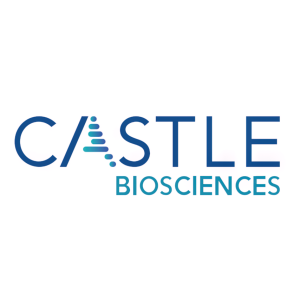Castle Biosciences Presents Data on DecisionDx®-Melanoma and DecisionDx® DiffDx™-Melanoma Tests at American Society of Dermatopathology (ASDP) 57th Virtual Annual Meeting
FRIENDSWOOD, Texas--(BUSINESS WIRE)--Castle Biosciences, Inc. (Nasdaq: CSTL), a skin cancer diagnostics company providing personalized genomic information to improve cancer treatment decisions, today announced the presentation of data on two of its skin cancer gene expression profile tests during the 57th Meeting of The American Society of Dermatopathology (ASDP).
DecisionDx®-Melanoma:
“Identifying predictors of sentinel lymph node metastasis in cutaneous melanoma patients using molecular and clinicopathologic high-risk features” was presented by Federico Monzon, M.D.
DecisionDx-Melanoma is Castle’s gene expression profile test that uses an individual patient’s tumor biology to predict individual risk of cutaneous melanoma metastasis or recurrence, as well as sentinel lymph node (SLN) positivity, independent of traditional staging factors.
“DecisionDx-Melanoma uses primary tumor biology to delineate patient metastatic risk, including the risk of SLN metastasis,” said Monzon. “In this study, among all features evaluated, DecisionDx-Melanoma was the most significant factor in predicting rates of SLN positivity, justifying a role for the test alongside other commonly used features in considering the sentinel lymph node biopsy surgical procedure.”
Study methods and findings:
- Authors modeled decision trees using the statistical R package for a cohort of 3,093 patients with cutaneous melanoma to determine which molecular and clinicopathologic features could best stratify the risk of patients’ receiving a positive result from a sentinel lymph node biopsy (SLNB).
-
DecisionDx-Melanoma was the most significant factor in distinguishing between high and low SLN-positivity rates (p<0.001).
-
Patients with a Class 2 (high-risk) DecisionDx-Melanoma result under age 75 or with a very high mitotic rate (>10/mm2) had the highest SLN-positivity rates (>
20% ). -
Conversely, patients with a Class 1A result over age 47 with tumors with no mitoses and those age 47 or younger with a Breslow thickness of 0.85mm or less had the lowest positivity rates (<
5% ), indicating they could potentially forego SLNB.
-
Patients with a Class 2 (high-risk) DecisionDx-Melanoma result under age 75 or with a very high mitotic rate (>10/mm2) had the highest SLN-positivity rates (>
-
Patients of all ages and Breslow thicknesses with a Class 2 result had a greater than
10% risk of SLN positivity, indicating that a Class 2 DecisionDx-Melanoma result can be considered a high-risk factor when considering the SLNB procedure for individual patients.
DecisionDx® DiffDx™-Melanoma:
“Development and validation of a diagnostic gene expression profile test for ambiguous or difficult-to-diagnose pigmented skin lesions” was presented by Sarah Estrada, M.D., FCAP.
DecisionDx DiffDx-Melanoma is designed to aid dermatopathologists in characterizing difficult-to-diagnose melanocytic lesions.
“Approximately 300,000 melanocytic lesions biopsied each year cannot be confidently identified as either malignant or benign, so the nature of these lesions remains ambiguous with discordant rates of diagnoses ranging from 25
Study methods and findings:
- DecisionDx DiffDx-Melanoma was designed to refine diagnoses of melanocytic neoplasms by providing clinicians with an objective ancillary tool with high accuracy.
- A total of 503 formalin-fixed paraffin-embedded (FFPE) tissue samples sourced from primary cutaneous melanoma tumors and melanocytic nevi were used, of which 273 were benign and 230 were malignant lesions. Samples underwent quantitative polymerase chain reaction (qPCR) to evaluate expression of 76 genes with potential diagnostic utility.
- Artificial intelligence approaches were used to select and prioritize gene sets, ultimately identifying 32 differentially expressed genes that reliably classified benign versus malignant melanocytic lesions.
-
The resulting 35-gene expression profile (GEP) test, DecisionDx DiffDx-Melanoma, (32 discriminant genes and 3 control genes) accurately diagnosed malignant and benign cases with
99.1% sensitivity,94.3% specificity,93.6% positive predictive value (PPV) and99.2% negative predictive value (NPV).
About DecisionDx-Melanoma
DecisionDx®-Melanoma is a gene expression profile test that uses an individual patient’s tumor biology to predict individual risk of cutaneous melanoma metastasis or recurrence, as well as sentinel lymph node positivity, independent of traditional staging factors, and has been studied in more than 5,700 patient samples. Using tissue from the primary melanoma, the test measures the expression of 31 genes. The test has been validated in four archival risk of recurrence studies of 901 patients and six prospective risk of recurrence studies including more than 1,600 patients. Prediction of the likelihood of sentinel lymph node positivity has also been validated in two prospective multicenter studies that included more than 3,000 patients. Impact on patient management plans for one of every two patients tested has been demonstrated in four multicenter and single-center studies including more than 560 patients. The consistent performance and accuracy demonstrated in these studies provides confidence in disease management plans that incorporate DecisionDx-Melanoma test results. Through September 30, 2020, DecisionDx-Melanoma has been ordered more than 64,560 times for use in patients with cutaneous melanoma.
More information about the test and disease can be found at www.SkinMelanoma.com.
About DecisionDx DiffDx-Melanoma
DecisionDx® DiffDx™-Melanoma is designed to aid dermatopathologists in characterizing difficult-to-diagnose melanocytic lesions. Of the 2 million suspicious pigmented lesions biopsied annually in the U.S., Castle estimates that approximately 300,000 of those cannot be confidently classified as either benign or malignant through traditional histopathology methods. DecisionDx DiffDx-Melanoma classifies these lesions as: benign (gene expression profile suggestive of benign neoplasm); intermediate-risk (gene expression profile cannot exclude malignancy); or malignant (gene expression profile suggestive of melanoma). Interpreted in the context of other clinical, laboratory and histopathologic information, DecisionDx DiffDx-Melanoma is designed to add diagnostic clarity and confidence for dermatopathologists while helping dermatologists deliver more informed patient management plans.
More information about the test and disease can be found at www.CastleTestInfo.com.
About Castle Biosciences
Castle Biosciences (Nasdaq: CSTL) is a commercial-stage dermatologic cancer company focused on providing physicians and their patients with personalized, clinically actionable genomic information to make more accurate treatment decisions. The Company currently offers tests for patients with cutaneous melanoma (DecisionDx®-Melanoma, DecisionDx®-CMSeq), cutaneous squamous cell carcinoma (DecisionDx®-SCC), suspicious pigmented lesions (DecisionDx® DiffDx™-Melanoma) and uveal melanoma (DecisionDx®-UM, DecisionDx®-PRAME and DecisionDx®-UMSeq). For more information about Castle’s gene expression profile tests, visit www.CastleTestInfo.com. Castle also has active research and development programs for tests in other dermatologic diseases with high clinical need. Castle Biosciences is based in Friendswood, Texas (Houston), and has laboratory operations in Phoenix, Arizona. For more information, visit www.CastleBiosciences.com.
DecisionDx-Melanoma, DecisionDx-CMSeq, DecisionDx-SCC, DecisionDx DiffDx-Melanoma, DecisionDx-UM, DecisionDx-PRAME and DecisionDx-UMSeq and are trademarks of Castle Biosciences, Inc.
Forward-Looking Statements
The information in this press release contains forward-looking statements and information within the meaning of Section 27A of the Securities Act of 1933, as amended, and Section 21E of the Securities Exchange Act of 1934, as amended, which are subject to the “safe harbor” created by those sections. These forward-looking statements include, but are not limited to, statements concerning the ability of DecisionDx DiffDx-Melanoma to accurately characterize difficult-to-diagnose melanocytic lesions, the ability of DecisionDx-Melanoma test results to help identify patients with low probability of sentinel lymph node positivity, and statements concerning each of their impact to optimize or improve treatment decisions and reduce healthcare costs. The words “anticipates,” “believes,” “estimates,” “expects,” “intends,” “may,” “plans,” “projects,” “will,” “would” and similar expressions are intended to identify forward-looking statements, although not all forward-looking statements contain these identifying words. We may not actually achieve the plans, intentions, or expectations disclosed in our forward-looking statements and you should not place undue reliance on our forward-looking statements. Actual results or events could differ materially from the plans, intentions and expectations disclosed in the forward-looking statements that we make. These forward-looking statements involve risks and uncertainties that could cause our actual results to differ materially from those in the forward-looking statements, including, without limitation, the effects of the COVID-19 pandemic on our business and our efforts to address its impact on our business and our ability to maintain compliance with the covenants in our debt facility, the timing and amount of revenue we are able to recognize in a given fiscal period, unexpected delays in planned launch of our pipeline products, the level and availability of reimbursement for our products, our ability to manage our anticipated growth and the risks set forth in our Annual Report on Form 10-K for the year ended December 31, 2019 and in our other filings with the SEC. The forward-looking statements are applicable only as of the date on which they are made, and we do not assume any obligation to update any forward-looking statements, except as may be required by law.









